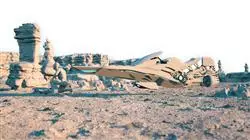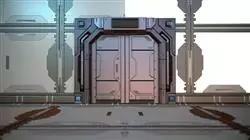University certificate
The world's largest faculty of design”
Introduction to the Program
Solve any challenge in the design and modeling of any steel structure thanks to the up to date content of this program"

A Hard Surface modeler has the ability to build, texture, light and render any element from scratch. Nowadays, it is a skill that is rewarded, as it gives a realistic idea of what a building, a bullet train, a modern kitchen and even a shoe might look like.
With this in mind, this Professional master’s degree in Hard Surface 3D Modeling will guide designers through an online program, which brings together all the necessary elements for the study of the shape and analysis of the composition that allows to generate a realistic modeling of any object. As a result, from the technical to the artistic, you will learn about the different fields in which this discipline is applicable, such as commercial animation, aeronautical engineering, the automotive sector, among others.
Therefore, first of all, a complete tour through the study of the figure and shape will be made, knowing in detail the development of the original figure and how, from them, different geometric bodies can be created. Then, an analysis of the various applicable modeling techniques and their principles can be made, which will favor the development of the criterion to perform 3D mesh mapping and texturing.
Continuing a little further in the syllabus, the student will learn how to perform advanced modeling in Rihno, one of the most popular software in the design world, which allows creating unimaginable shapes with great precision and detail. Finally, special emphasis will be placed on the production of characters using Hard Surface, understanding the parameters for sculpting them.
For all these reasons and more, this program is the right choice for designers who wish to advance their careers or update their knowledge in a highly demanded area. Thanks to the 100% online modality, you will be able to organize your time and learning pace according to your schedule and responsibility. Additionally, you will have access to the contents at any time and place you need it.
Be a surface modeling artist thanks to the up to date content of this 100% online program from TECH Global University"
This Professional master’s degree in Hard Surface 3D Modeling contains the most complete and up-to-date educational program on the market. The most important features include:
- The development of practical cases presented by experts in Hard Surface 3D modeling
- The graphic, schematic, and practical contents with which they are created, provide practical information on the disciplines that are essential for professional practice
- Practical exercises where self assessment can be used to improve learning
- Its special emphasis on innovative methodologies
- Theoretical lessons, questions to the expert, debate forums on controversial topics, and individual reflection assignments
- Content that is accessible from any fixed or portable device with an Internet connection
By enrolling in this program, you will be able to broaden your professional options, venturing into fields such as engineering, aeronautics or the automotive sector"
The program’s teaching staff includes professionals from the sector who contribute their work experience to this training program, as well as renowned specialists from leading societies and prestigious universities.
The multimedia content, developed with the latest educational technology, will provide the professional with situated and contextual learning, i.e., a simulated environment that will provide immersive education programmed to learn in real situations.
This program is designed around Problem-Based Learning, whereby the professional must try to solve the different professional practice situations that arise throughout the program. For this purpose, the student will be assisted by an innovative interactive video system created by renowned and experienced experts.
Through practical examples and didactic videos, you will acquire in depth knowledge about the use of 3D mesh mapping"

Become familiar with the application and development of the most commonly used modifiers in 3D Studio Max"
Why study at TECH?
TECH is the world’s largest online university. With an impressive catalog of more than 14,000 university programs available in 11 languages, it is positioned as a leader in employability, with a 99% job placement rate. In addition, it relies on an enormous faculty of more than 6,000 professors of the highest international renown.

Study at the world's largest online university and guarantee your professional success. The future starts at TECH”
The world’s best online university according to FORBES
The prestigious Forbes magazine, specialized in business and finance, has highlighted TECH as “the world's best online university” This is what they have recently stated in an article in their digital edition in which they echo the success story of this institution, “thanks to the academic offer it provides, the selection of its teaching staff, and an innovative learning method aimed at educating the professionals of the future”
A revolutionary study method, a cutting-edge faculty and a practical focus: the key to TECH's success.
The most complete study plans on the university scene
TECH offers the most complete study plans on the university scene, with syllabuses that cover fundamental concepts and, at the same time, the main scientific advances in their specific scientific areas. In addition, these programs are continuously being updated to guarantee students the academic vanguard and the most in-demand professional skills. In this way, the university's qualifications provide its graduates with a significant advantage to propel their careers to success.
TECH offers the most comprehensive and intensive study plans on the current university scene.
A world-class teaching staff
TECH's teaching staff is made up of more than 6,000 professors with the highest international recognition. Professors, researchers and top executives of multinational companies, including Isaiah Covington, performance coach of the Boston Celtics; Magda Romanska, principal investigator at Harvard MetaLAB; Ignacio Wistumba, chairman of the department of translational molecular pathology at MD Anderson Cancer Center; and D.W. Pine, creative director of TIME magazine, among others.
Internationally renowned experts, specialized in different branches of Health, Technology, Communication and Business, form part of the TECH faculty.
A unique learning method
TECH is the first university to use Relearning in all its programs. It is the best online learning methodology, accredited with international teaching quality certifications, provided by prestigious educational agencies. In addition, this disruptive educational model is complemented with the “Case Method”, thereby setting up a unique online teaching strategy. Innovative teaching resources are also implemented, including detailed videos, infographics and interactive summaries.
TECH combines Relearning and the Case Method in all its university programs to guarantee excellent theoretical and practical learning, studying whenever and wherever you want.
The world's largest online university
TECH is the world’s largest online university. We are the largest educational institution, with the best and widest online educational catalog, one hundred percent online and covering the vast majority of areas of knowledge. We offer a large selection of our own degrees and accredited online undergraduate and postgraduate degrees. In total, more than 14,000 university degrees, in eleven different languages, make us the largest educational largest in the world.
TECH has the world's most extensive catalog of academic and official programs, available in more than 11 languages.
Google Premier Partner
The American technology giant has awarded TECH the Google Google Premier Partner badge. This award, which is only available to 3% of the world's companies, highlights the efficient, flexible and tailored experience that this university provides to students. The recognition as a Google Premier Partner not only accredits the maximum rigor, performance and investment in TECH's digital infrastructures, but also places this university as one of the world's leading technology companies.
Google has positioned TECH in the top 3% of the world's most important technology companies by awarding it its Google Premier Partner badge.
The official online university of the NBA
TECH is the official online university of the NBA. Thanks to our agreement with the biggest league in basketball, we offer our students exclusive university programs, as well as a wide variety of educational resources focused on the business of the league and other areas of the sports industry. Each program is made up of a uniquely designed syllabus and features exceptional guest hosts: professionals with a distinguished sports background who will offer their expertise on the most relevant topics.
TECH has been selected by the NBA, the world's top basketball league, as its official online university.
The top-rated university by its students
Students have positioned TECH as the world's top-rated university on the main review websites, with a highest rating of 4.9 out of 5, obtained from more than 1,000 reviews. These results consolidate TECH as the benchmark university institution at an international level, reflecting the excellence and positive impact of its educational model.” reflecting the excellence and positive impact of its educational model.”
TECH is the world’s top-rated university by its students.
Leaders in employability
TECH has managed to become the leading university in employability. 99% of its students obtain jobs in the academic field they have studied, within one year of completing any of the university's programs. A similar number achieve immediate career enhancement. All this thanks to a study methodology that bases its effectiveness on the acquisition of practical skills, which are absolutely necessary for professional development.
99% of TECH graduates find a job within a year of completing their studies.
Professional Master's Degree in Hard Surface 3D Modeling
?
The industry and three-dimensional techniques are evolving at an accelerated pace, bringing with them innovative ways of representation, design and animation. The impact of shapes and figures, three-dimensional drawings and mechanical and flexible elements are now more than ever joined with stories and tales that go beyond our imagination by means of science fiction characters and surfaces that surpass our reality, in short: a whole set of elements, techniques and visual effects that are part of the world of video games, entertainment and film production. Based on this accelerated and vertiginous awakening of the audiovisual industry, TECH Global University has designed a Professional Master's Degree in Hard Surface 3D Modeling. A study program with highly qualified academic content for you to perfect your design and rendering techniques.
Take a Professional Master's Degree at TECH Global University.
?
The Professional Master's Degree in Hard Surface 3D Modeling, has a complete study plan that will allow the student to access in a fast and flexible way, 100% online, to all the content related to surface modeling. This professional master's degree includes the main theoretical and practical knowledge in order to know the different types of modeling, the basics of 3D modeling in its various forms and accredit you as a technical expert in modeling, recognizing the concepts to apply them in the 3D modeling industry. Our purpose is to offer all the knowledge that the designer needs to master the most important modeling programs in the world, and in this sense provides you with a highly qualified faculty, expert designers, a fully updated agenda, the best learning method, known as Relearning, and a virtual platform within reach of your needs, in order for you to become one of the best designers in the audiovisual industry.







